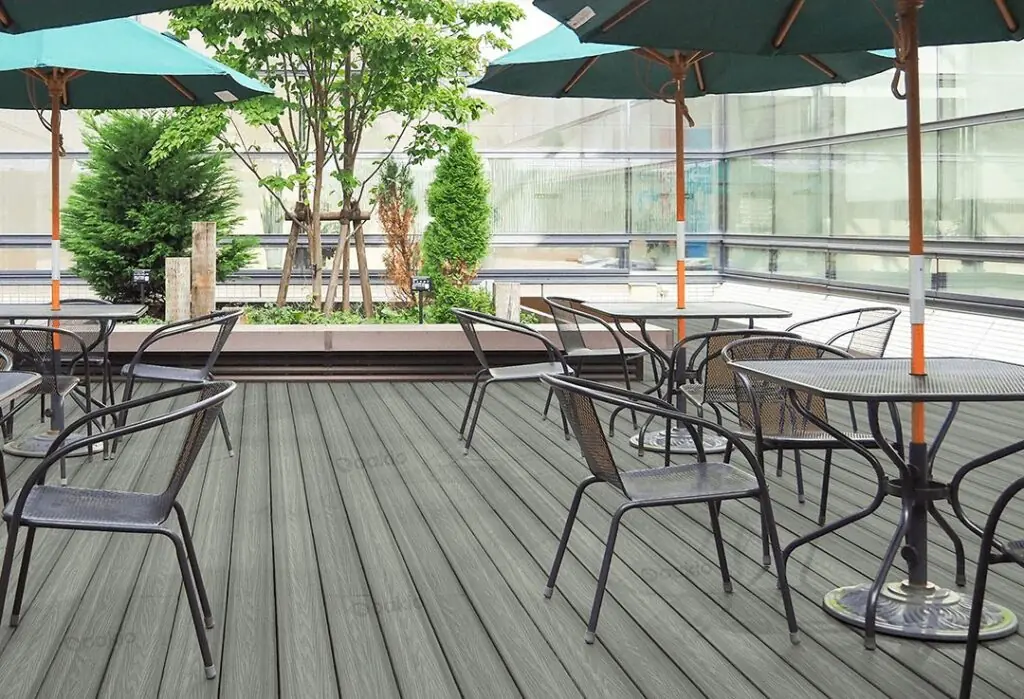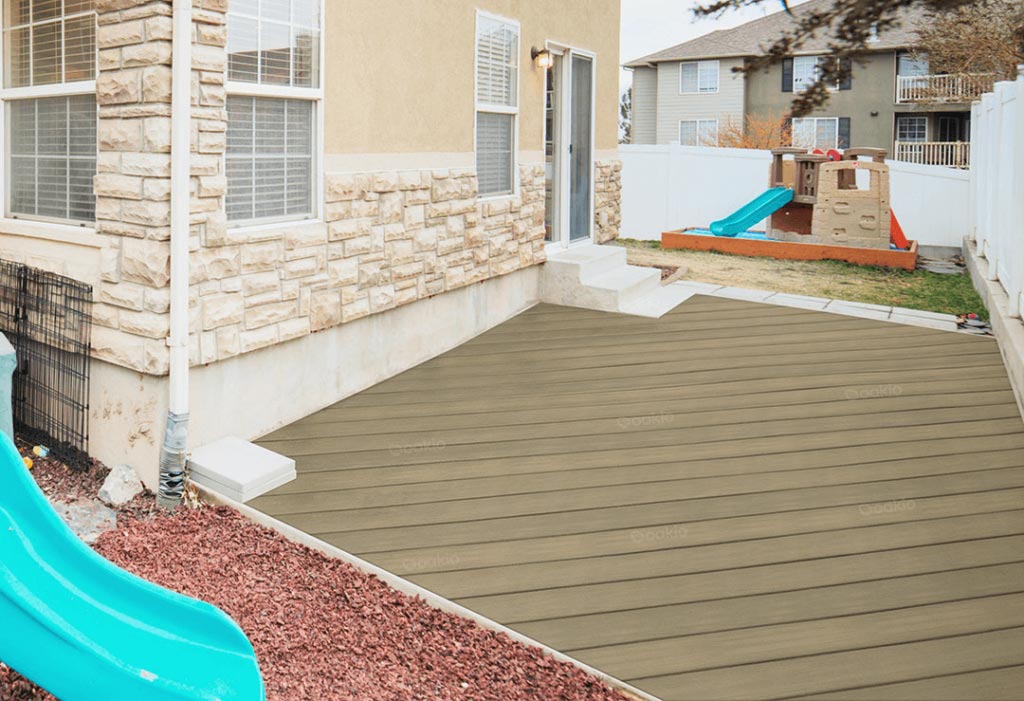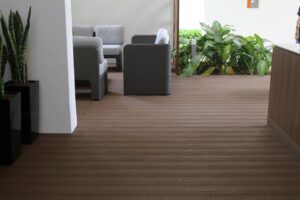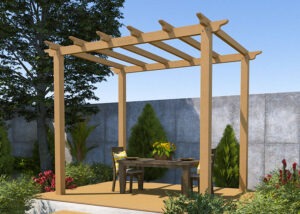How to Build an Under-Deck Drainage System?
A water-damaged deck is one of the costliest and most effort-intensive problems a homeowner can face, which is why many homeowners are wondering how to build an under-deck drainage system so the water can freely flow without damaging their decks.
Though waterproof decking materials help, augmenting their water resistance with a drainage system to redirect water flow is better to keep the deck low-maintenance, long-lasting, and aesthetic for many years to come.
An under-deck drainage system efficiently redirects damaging water flow to ensure a dry space beneath the deck, which protects against moisture. But how do you build one? Let’s discuss this further below!
Why Do You Need an Under-Deck Drainage System?

An under-deck drainage system is a water diversion system designed to store and channel water away from the area beneath your deck. The system keeps it dry and protected from mold and mildew growth, warping, rotting, and cracking.
This system usually consists of membranes or panels that are attached to the deck boards to channel rainwater to a gutter. With this, the space beneath the deck is clean and dry, and can even be used as a spare storage space.
Though this system channels water away from underneath the deck, the system works better when paired with conventional waterproofing methods. But in case you have an old deck with no waterproofing layers, this system can still work well on its own.
Installing one in your existing deck can extend its lifespan and reduce the costs of any future repairs caused by warping, rotting, or mold growth. If you invest in a decking drainage system, you can preserve your deck and ensure safety for all users involved without spending too much on a new deck!
The Kinds of Under-Deck Drainage Systems
There are two types of under-deck drainage systems available: the undermount and overmount. Though they differ in structure installation, design, and material, both can protect your deck’s surface and understructure sufficiently.
Undermount Drainage System
The undermount system is installed beneath the deck joist, hence the name. An undermount system is a good choice if you have an existing deck as it provides installation flexibility and ease.
This system attaches panels or membranes beneath the deck’s substructure to store water as it seeps into the cracks between the deck boards. These panels or membranes then channel the water away from the deck through a gutter system.
Undermount decking drainage is often made from durable, waterproof plastics such as PVC. The installation process is also easy, though it requires a precise eye to make sure it catches optimal draining angles.
The disadvantage of this system, however, is that they are more visible from the underside and can potentially affect the overall aesthetic of your deck.
Overmount Drainage System
Overmount systems, in contrast, are installed on top of the deck joists before the boards are laid and attached—this installation method keeps the system hidden in plain sight. The drainage membranes are also placed between the joists and boards, offering complete concealment.
However, this system is better suited to new decks as the installation process is complicated and needs all deck boards and joists to be cleared to make way. The overmount system is typically made from rubber or polyethylene to ensure water resistance.
In comparison with undermount systems, they offer better protection for the substructure of your deck since they catch water before reaching the framing of the deck itself—though they need a complex installation process.
All in all, if you want an easy installation, especially on already existing decks, an undermount system is better. But if you’re starting from scratch, an overmount can be better as it provides superior protection than the latter.
Building an Under-Deck Drainage System
Building an under-deck drainage system can be done in these simple steps:
1. Measure the deck area (if undermount) using a laser measure or a long tape measure to determine the amount of drainage material to buy or measure the land area you’re planning to install a deck on (if overmount).
2. Gather the materials needed. You’ll need screws, gutters, and waterproof membranes or panels for an undermount system. For an overmount, you’ll need membranes or drainage panels that can fit between the joists and deck boards.
3. Install the panels or membranes. For an undermount system, attach the panels or membranes below the joists, ensuring there’s a slope to direct water into the gutter. For an overmount, install the membranes over the joists before installing the deck boards.
4. Next up is to install the gutters and downspouts so rainwater can be channeled effectively away from the deck substructure and framing system.
5. Test the system. Pour a good amount of water into the spaces between the deck boards to simulate rainwater and see if the system works correctly.
Aside from these steps, it’s also helpful to consider these factors into play:
Cost
An undermount drainage system may cost around $4 to $6 per square foot. While an overmount may cost around $8 to $10 per square foot. These costs may be higher or lower depending on material prices.
Installation Duration
You can install both undermount and overmount deck drainage systems for 2-3 days if you decide to DIY (do it yourself), depending on your experience and skill. Should you decide to go for a professional installation, you can expect a turnaround time of 1-2 days.
DIY Possibilities
Undermount systems are DIY-friendly, and you can definitely install one with basic carpentry skills, tools, and equipment. Overmount systems are more complex and typically require the expertise of a professional to ensure perfect rainwater coverage.
What are the Benefits?
Under-deck drainage systems offer a myriad of benefits:
1. Extends Deck Lifespan
- Protects deck substructure from moisture and water intrusion, preventing mold growth, rotting, and warping.
- Extends the lifespan of both natural wood and composite decking materials.
- Prolongs the lifespan of composites even longer than what’s commonly advertised.
2. Maximizes Value
- Increases the overall value by offering protection to the deck and surrounding structures.
- Prevents and minimizes costly repairs brought about by daily wear and tear, and moisture-related damages.
- Prevents water intrusion into other parts of the house, such as the foundations.
3. Provides an Additional Usable Space
- An under-deck system provides a clean and dry space beneath the deck for added storage space.
- Maximizes the overall functionality of your outdoor space.
4. Improves Aesthetics and Comfort
- Enhances the overall aesthetics of the deck, and the outdoor space in general.
- Allows homeowners to add furniture without the fear of the deck boards giving in to the weight because of water damage.
- Makes the area safe to walk in regardless of whether it’s raining or not.
Overall, an under-deck drainage system boasts a host of advantages every homeowner will love!
Build with Oakio Today!
Protecting your deck investment is a multi-pronged approach, from using waterproof materials to installing an efficient deck drainage system, doing these ensures your deck will be safe and sound for years to come.
Oakio is a leading innovator and producer of water-resistant composite decking materials, offering you premium quality deck solutions you need to make your deck last for years and even decades!
With our focus on sustainability, durability, and aesthetics, you will never go wrong with our suite of decking products! Build your dream deck with Oakio today!
Subscribe to our newsletter today and get the latest how-tos, expert tips, deals, and discounts straight to your inbox!
Trending Reading
What Are the Differences Between the WPC Board and PVC Board?
[2024 Update] How Long Does WPC Decking Last?









